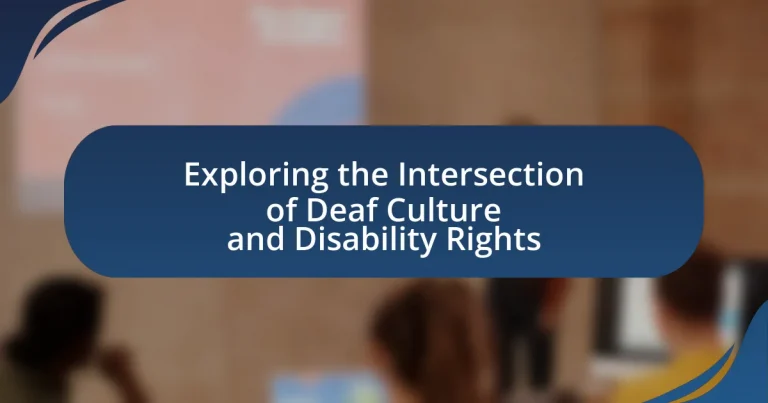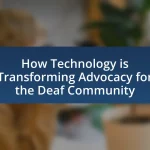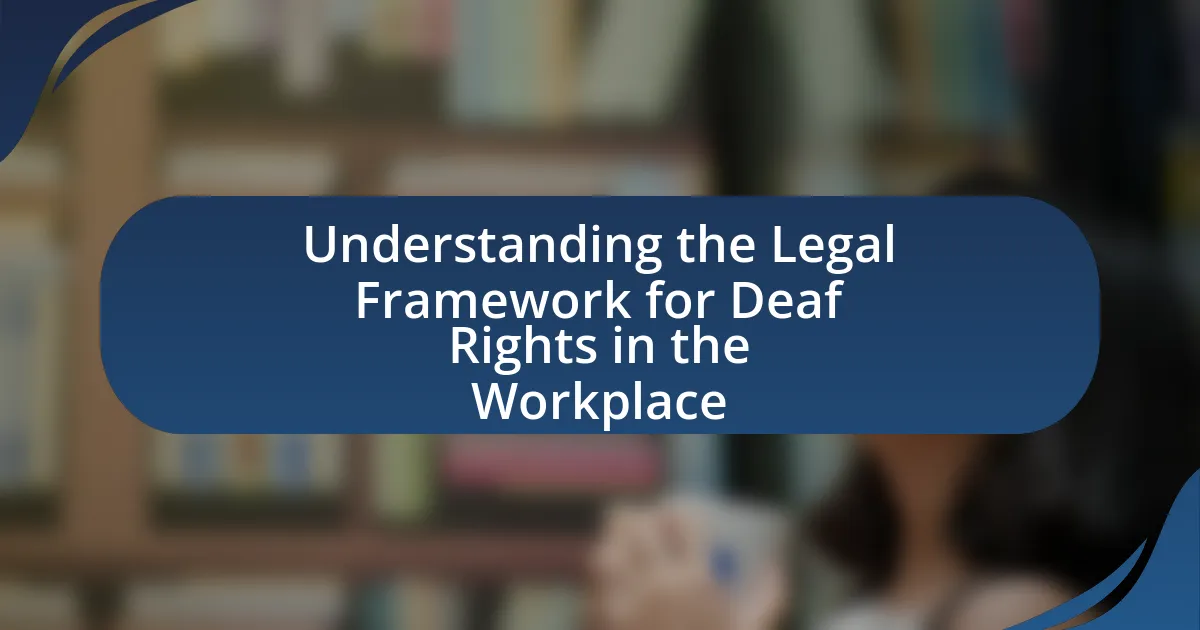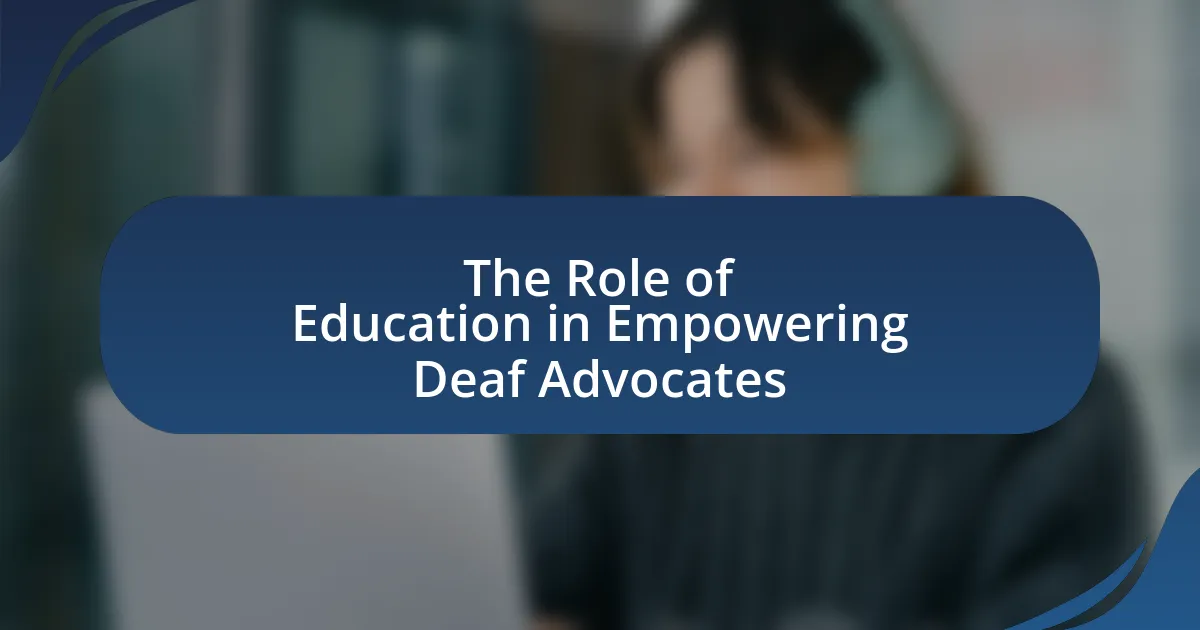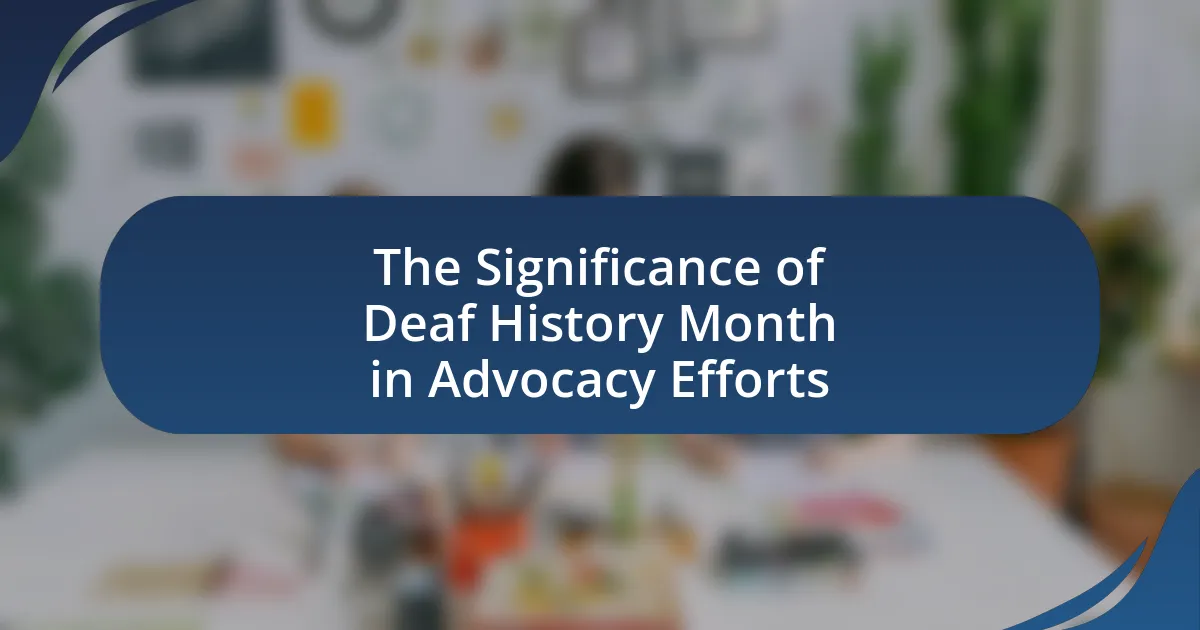The article explores the intersection of Deaf culture and disability rights, highlighting the shared advocacy for recognition, accessibility, and equality among Deaf individuals. It examines the historical contexts that have shaped both movements, including the significance of the Americans with Disabilities Act (ADA) in reinforcing the rights of Deaf individuals. The article discusses how societal perceptions influence the understanding of Deaf identity, the unique challenges faced by the Deaf community within the disability rights movement, and the importance of tailored advocacy efforts. Additionally, it outlines the specific rights relevant to the Deaf community and the impact of legislation on their access to resources and opportunities.
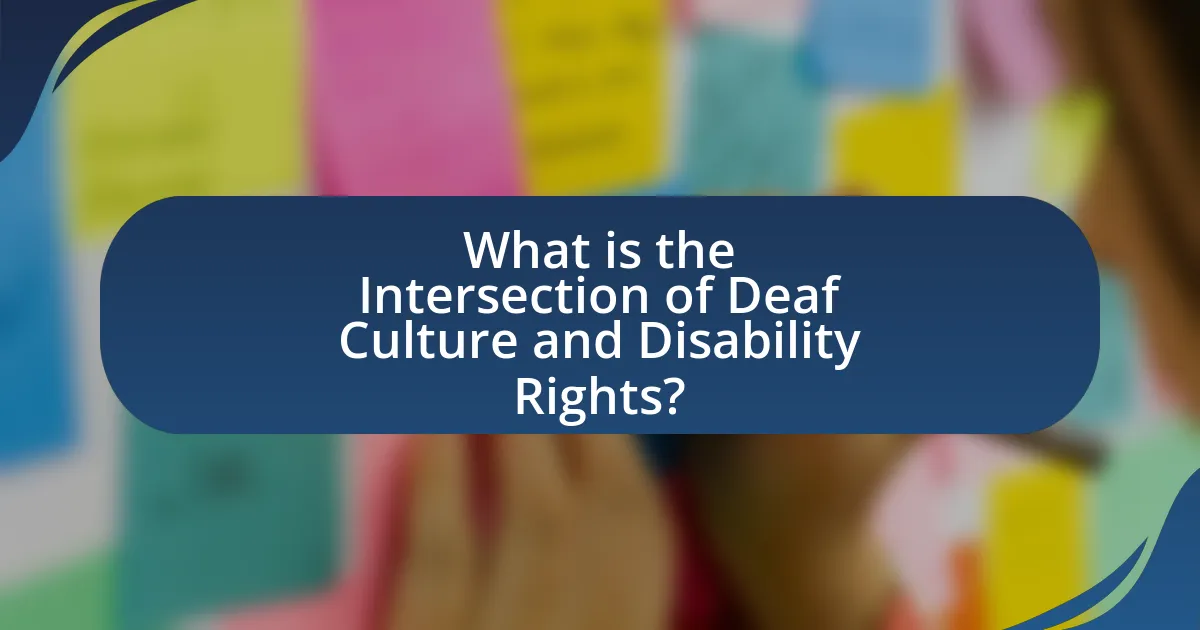
What is the Intersection of Deaf Culture and Disability Rights?
The intersection of Deaf culture and disability rights lies in the shared advocacy for recognition, accessibility, and equality. Deaf culture emphasizes the unique identity, language (American Sign Language, for example), and community of Deaf individuals, while disability rights focus on the broader movement for the rights of all individuals with disabilities. Both movements advocate against discrimination and for equal access to education, employment, and public services. Historical milestones, such as the Americans with Disabilities Act (ADA) of 1990, have reinforced the rights of Deaf individuals, ensuring that they receive the same protections and opportunities as other people with disabilities. This intersection highlights the importance of cultural identity within the disability rights framework, promoting a more inclusive understanding of disability that respects and values Deaf culture.
How do Deaf Culture and Disability Rights relate to each other?
Deaf Culture and Disability Rights are interconnected as both advocate for the recognition and respect of diverse identities and experiences within the disability community. Deaf Culture emphasizes the importance of sign language, community, and shared experiences among Deaf individuals, while Disability Rights focus on ensuring equal access, opportunities, and protections for all individuals with disabilities. The Americans with Disabilities Act (ADA) of 1990, for instance, provides legal protections that benefit both Deaf individuals and the broader disability community by prohibiting discrimination and promoting accessibility. This legal framework supports the cultural identity of Deaf individuals while reinforcing their rights as part of the larger movement for disability rights.
What are the historical contexts of Deaf Culture and Disability Rights?
Deaf Culture and Disability Rights have evolved through significant historical contexts that highlight the struggle for recognition and equality. The establishment of American Sign Language (ASL) in the 19th century, particularly with the founding of Gallaudet University in 1864, marked a pivotal moment in Deaf Culture, fostering a sense of community and identity among Deaf individuals. Concurrently, the Disability Rights Movement gained momentum in the mid-20th century, advocating for the rights of individuals with disabilities, including Deaf individuals, to access education, employment, and public services. Landmark legislation such as the Americans with Disabilities Act (ADA) of 1990 further solidified these rights, ensuring that Deaf individuals are recognized as part of the broader disability community. This intersection of Deaf Culture and Disability Rights reflects a shared history of advocacy for inclusion and equal treatment in society.
How have societal perceptions shaped the intersection of these two areas?
Societal perceptions have significantly shaped the intersection of Deaf culture and disability rights by influencing the recognition and validation of Deaf identity as a cultural and linguistic minority rather than solely a disability. This shift in perception has led to increased advocacy for the rights of Deaf individuals, emphasizing the importance of sign language and cultural heritage. For instance, the passage of the Americans with Disabilities Act in 1990 marked a pivotal moment, as it acknowledged the need for accessibility and equal rights for individuals with disabilities, including those in the Deaf community. Furthermore, the growing acceptance of Deaf culture in educational and social contexts has fostered a more inclusive environment, promoting awareness and understanding of Deaf issues within the broader disability rights movement.
Why is understanding this intersection important?
Understanding the intersection of Deaf culture and disability rights is crucial because it highlights the unique challenges and experiences faced by Deaf individuals within the broader disability community. This understanding fosters inclusivity and informs policies that protect the rights of Deaf people, ensuring they receive equitable access to resources, education, and employment opportunities. Research indicates that Deaf individuals often encounter barriers that are distinct from those faced by other disabled groups, such as communication access and cultural recognition, which underscores the need for tailored advocacy efforts. By recognizing these specific needs, stakeholders can develop more effective strategies to promote social justice and equality for Deaf individuals, ultimately enhancing their quality of life and participation in society.
What impact does this intersection have on policy-making?
The intersection of Deaf culture and disability rights significantly influences policy-making by promoting inclusive legislation that recognizes the unique needs of Deaf individuals. This intersection encourages policymakers to consider accessibility in communication, education, and employment, leading to laws such as the Americans with Disabilities Act, which mandates accommodations for Deaf individuals. Furthermore, advocacy from Deaf organizations highlights the importance of cultural identity, pushing for policies that not only address disability but also affirm Deaf culture, thereby shaping a more comprehensive approach to disability rights.
How does it influence community advocacy and activism?
Deaf culture significantly influences community advocacy and activism by promoting awareness and understanding of the unique challenges faced by Deaf individuals. This cultural framework fosters solidarity among Deaf individuals, empowering them to advocate for their rights and access to services. For instance, the establishment of organizations like the National Association of the Deaf has led to successful campaigns for legislation such as the Americans with Disabilities Act, which ensures equal rights and accessibility for individuals with disabilities, including those who are Deaf. This intersection of Deaf culture and disability rights advocacy highlights the importance of representation and the need for tailored approaches to address specific community needs.
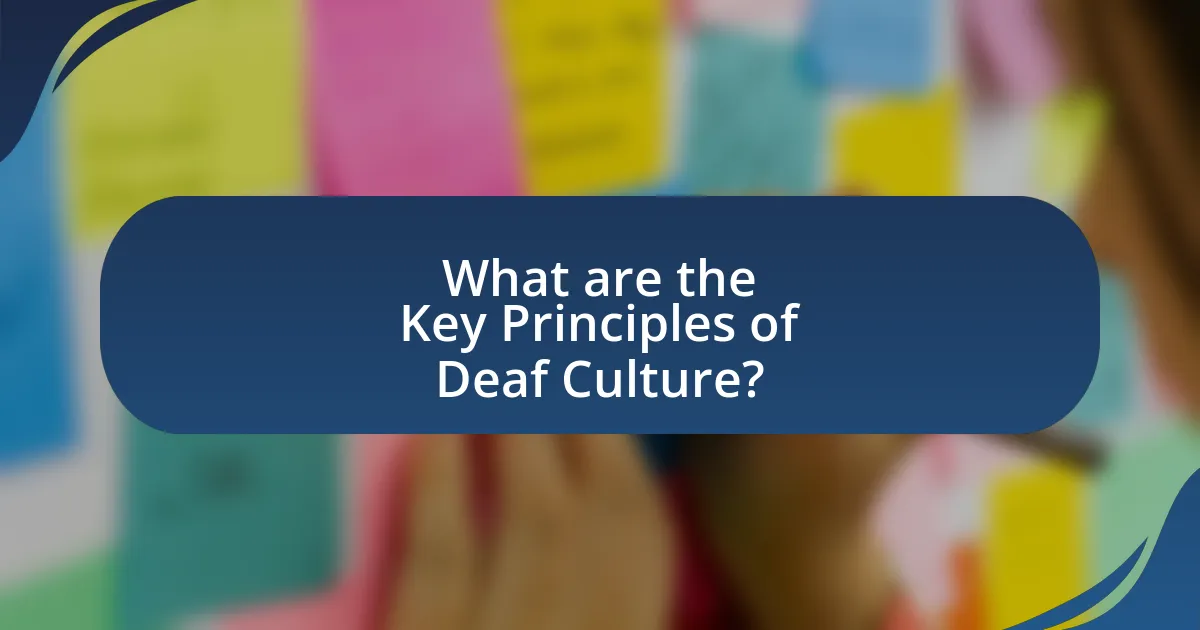
What are the Key Principles of Deaf Culture?
The key principles of Deaf culture include the use of sign language as a primary mode of communication, a strong sense of community and identity among Deaf individuals, and the value placed on visual communication and expression. Sign language, such as American Sign Language (ASL), is not merely a tool for communication but a vital part of cultural identity, facilitating social connections and cultural transmission. The Deaf community emphasizes shared experiences and collective identity, fostering a sense of belonging and support. Additionally, visual communication is prioritized, with Deaf individuals often relying on facial expressions, body language, and spatial awareness to convey meaning effectively. These principles are foundational to understanding Deaf culture and its distinct social norms and values.
How is Deaf Culture defined and expressed?
Deaf Culture is defined as a unique social and cultural identity formed by individuals who are deaf or hard of hearing, characterized by shared experiences, values, and communication methods, primarily through sign language. This culture is expressed through various forms, including visual art, literature, theater, and social gatherings, which emphasize the importance of community and shared identity among deaf individuals. For instance, American Sign Language (ASL) serves not only as a means of communication but also as a vital component of cultural expression, facilitating storytelling and the transmission of cultural norms. The recognition of Deaf Culture is supported by historical movements advocating for the rights and visibility of deaf individuals, such as the establishment of Deaf schools and organizations that promote deaf heritage and identity.
What are the core values and beliefs within Deaf Culture?
The core values and beliefs within Deaf Culture include a strong emphasis on community, identity, and the use of sign language as a primary mode of communication. Deaf individuals often view their deafness not as a disability but as a unique cultural identity, fostering a sense of belonging and solidarity among members. This cultural perspective is reinforced by the shared experiences and history of the Deaf community, which advocate for the recognition of sign language as a legitimate language and promote access to education and resources in sign language. The belief in the importance of visual communication and the value of Deaf heritage further solidifies the community’s commitment to preserving and celebrating their culture.
How does language play a role in Deaf identity?
Language is fundamental to Deaf identity as it serves as the primary means of communication and cultural expression within the Deaf community. Sign languages, such as American Sign Language (ASL), are not merely tools for communication; they embody the cultural values, social norms, and shared experiences of Deaf individuals. Research indicates that sign language fosters a sense of belonging and identity among Deaf people, as it allows for the transmission of cultural narratives and collective memory. For instance, studies show that Deaf individuals who use sign language are more likely to identify strongly with Deaf culture, highlighting the integral role language plays in shaping their identity and community cohesion.
What challenges does Deaf Culture face within the disability rights movement?
Deaf Culture faces significant challenges within the disability rights movement, primarily due to a lack of understanding and recognition of its unique linguistic and cultural identity. Many disability rights advocates often view disability through a medical model, which emphasizes impairment rather than the social and cultural aspects of being Deaf. This perspective can lead to the marginalization of Deaf individuals within broader disability discussions, as their needs for communication access, such as sign language interpretation, may be overlooked. Additionally, there is often a tension between the Deaf community’s desire for cultural preservation and the mainstream disability rights movement’s focus on integration and accommodation, which can create divisions and hinder collaborative efforts.
How do misconceptions about Deaf individuals affect their rights?
Misconceptions about Deaf individuals significantly undermine their rights by perpetuating stereotypes that lead to discrimination and exclusion. For instance, the belief that Deaf individuals cannot communicate effectively often results in inadequate access to education and employment opportunities, violating their rights under laws such as the Americans with Disabilities Act (ADA). Research indicates that 70% of Deaf individuals report facing barriers in accessing services due to these misconceptions, which directly impacts their ability to participate fully in society. Furthermore, misconceptions can lead to a lack of understanding of Deaf culture, which is essential for recognizing the rights of Deaf individuals to use sign language as their primary mode of communication, further entrenching systemic inequalities.
What barriers exist in accessing resources and support?
Barriers in accessing resources and support for individuals within Deaf culture include communication challenges, lack of awareness among service providers, and insufficient funding for specialized services. Communication barriers arise when resources are not available in sign language or accessible formats, limiting effective interaction. Research indicates that many service providers lack training in Deaf culture, leading to misunderstandings and inadequate support. Additionally, funding constraints often result in limited availability of tailored programs, which further restricts access to necessary resources. For instance, a study by the National Association of the Deaf highlights that only 30% of Deaf individuals report having access to appropriate services, underscoring the systemic issues present in resource accessibility.
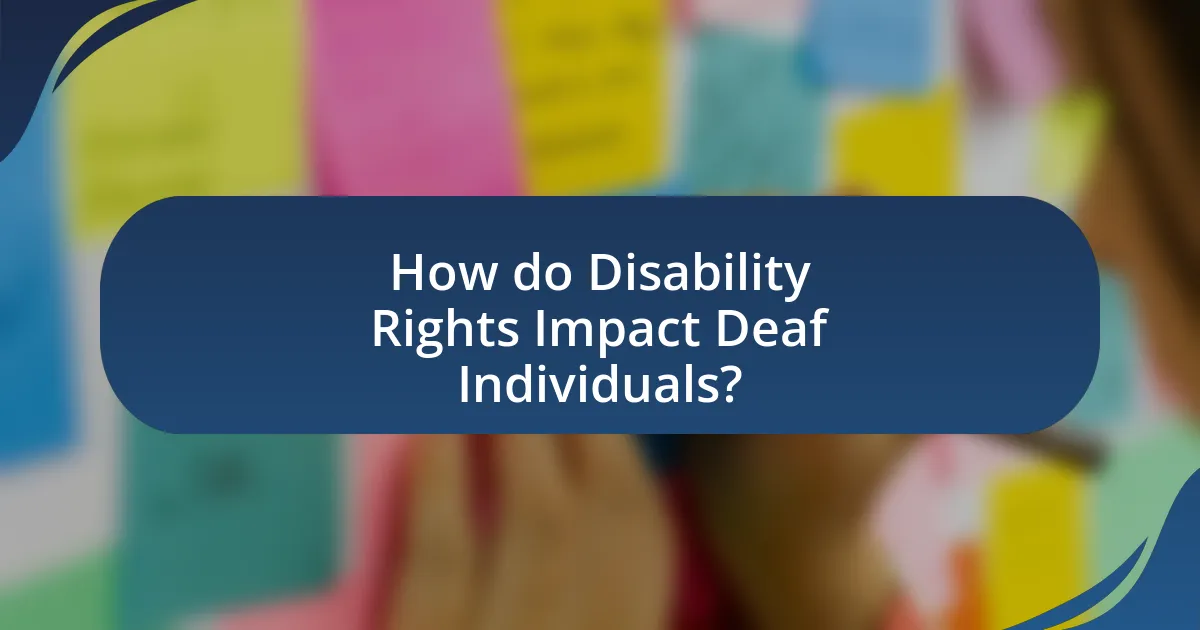
How do Disability Rights Impact Deaf Individuals?
Disability rights significantly impact Deaf individuals by ensuring their access to communication, education, and employment opportunities. Legislation such as the Americans with Disabilities Act (ADA) mandates that public services and accommodations be accessible, which includes providing sign language interpreters and other communication aids. This legal framework supports Deaf individuals in asserting their rights to equal treatment and participation in society. For instance, studies show that access to interpreters in educational settings leads to improved academic outcomes for Deaf students, highlighting the importance of these rights in fostering inclusion and equity.
What specific rights are relevant to the Deaf community?
The specific rights relevant to the Deaf community include the right to accessible communication, the right to education in sign language, and the right to equal employment opportunities. Accessible communication rights ensure that Deaf individuals can access information in formats they understand, such as sign language interpreters or captioning services. The right to education in sign language allows Deaf children to learn in their native language, which is crucial for cognitive development and social integration. Equal employment opportunities guarantee that Deaf individuals are not discriminated against in hiring practices and have access to reasonable accommodations in the workplace. These rights are supported by legislation such as the Americans with Disabilities Act (ADA) and the Individuals with Disabilities Education Act (IDEA), which mandate accessibility and non-discrimination for individuals with disabilities, including those who are Deaf.
How do laws like the Americans with Disabilities Act support Deaf individuals?
The Americans with Disabilities Act (ADA) supports Deaf individuals by prohibiting discrimination based on disability and ensuring equal access to services and opportunities. The ADA mandates that public and private entities provide effective communication, which includes the provision of sign language interpreters and other accommodations for Deaf individuals. This legal framework is crucial as it empowers Deaf individuals to participate fully in society, including employment, education, and public services, thereby enhancing their quality of life and promoting inclusion.
What are the limitations of current disability rights legislation for the Deaf?
Current disability rights legislation for the Deaf often fails to adequately address the unique communication needs and cultural identity of Deaf individuals. For instance, the Americans with Disabilities Act (ADA) does not specifically mandate the provision of sign language interpreters in all public settings, which can lead to barriers in accessing essential services such as healthcare and education. Additionally, the legislation does not fully recognize Deaf culture as a distinct linguistic and cultural community, which can result in a lack of tailored support and resources. Studies indicate that only 36% of Deaf individuals report having access to qualified interpreters in critical situations, highlighting the inadequacy of existing laws to ensure equal access and participation.
How can advocacy improve the intersection of Deaf Culture and Disability Rights?
Advocacy can improve the intersection of Deaf Culture and Disability Rights by promoting awareness and understanding of the unique challenges faced by Deaf individuals within the broader disability community. Effective advocacy efforts can lead to policy changes that ensure equal access to services, education, and employment opportunities for Deaf individuals, thereby reinforcing their rights as both members of the Deaf community and individuals with disabilities. For instance, the Americans with Disabilities Act (ADA) mandates reasonable accommodations for individuals with disabilities, including those who are Deaf, which has been bolstered by advocacy groups that highlight the importance of sign language access and communication rights.
What strategies can be employed to enhance awareness and understanding?
To enhance awareness and understanding of Deaf culture and disability rights, educational initiatives that include workshops, seminars, and community outreach programs can be employed. These strategies facilitate direct engagement with Deaf individuals and their experiences, fostering empathy and knowledge among participants. Research indicates that immersive experiences, such as sign language classes and cultural exchange programs, significantly improve understanding of Deaf culture (Humphries et al., 2012, “Deaf Culture: A Review of the Literature,” Journal of Deaf Studies and Deaf Education). Additionally, collaboration with advocacy organizations can amplify messages and create platforms for dialogue, further promoting awareness and understanding within broader communities.
How can collaboration between Deaf organizations and disability rights groups be fostered?
Collaboration between Deaf organizations and disability rights groups can be fostered through joint advocacy initiatives and shared educational programs. By aligning their goals, both entities can work together to promote accessibility and inclusion for Deaf individuals within the broader disability rights framework. For instance, collaborative campaigns can address common issues such as communication access and discrimination, thereby amplifying their collective voice. Research indicates that partnerships between diverse disability groups lead to more comprehensive policy changes, as seen in the 2017 report by the National Council on Disability, which highlighted successful collaborations that improved access to services for various disability communities.
What practical steps can individuals take to support this intersection?
Individuals can support the intersection of Deaf culture and disability rights by advocating for inclusive policies that recognize and protect the rights of Deaf individuals. This includes promoting the use of American Sign Language (ASL) in educational settings, ensuring access to interpreters in public services, and supporting legislation that mandates equal access to communication. Research indicates that inclusive practices improve educational outcomes for Deaf students, as evidenced by a study published in the Journal of Deaf Studies and Deaf Education, which found that Deaf students perform better in environments where ASL is used as a primary mode of communication. Additionally, individuals can participate in awareness campaigns that highlight the unique challenges faced by Deaf individuals within the broader disability rights movement, fostering a more inclusive society.
How can allies effectively advocate for Deaf rights within the disability rights framework?
Allies can effectively advocate for Deaf rights within the disability rights framework by actively promoting inclusive policies and practices that recognize the unique linguistic and cultural identity of Deaf individuals. This advocacy includes supporting legislation that ensures access to sign language interpretation in public services and educational settings, which is essential for equal participation. For instance, the Americans with Disabilities Act mandates reasonable accommodations, including effective communication access, which directly benefits Deaf individuals. Additionally, allies should engage in awareness campaigns that educate the broader community about Deaf culture and the importance of sign language, thereby fostering an environment of respect and understanding. By collaborating with Deaf organizations and amplifying Deaf voices in decision-making processes, allies can ensure that advocacy efforts are aligned with the needs and perspectives of the Deaf community.
What resources are available for education and advocacy in this area?
Resources available for education and advocacy in the intersection of Deaf culture and disability rights include organizations such as the National Association of the Deaf (NAD), which provides advocacy, education, and resources for Deaf individuals. The NAD offers materials on legal rights, access to education, and community support. Additionally, the American Speech-Language-Hearing Association (ASHA) provides resources on communication access and advocacy for individuals with hearing loss. Research studies, such as “Deaf Culture and Disability Rights: A Comparative Analysis” published in the Journal of Disability Policy Studies, highlight the importance of integrating Deaf culture into broader disability rights discussions, reinforcing the need for tailored educational programs and advocacy efforts.
